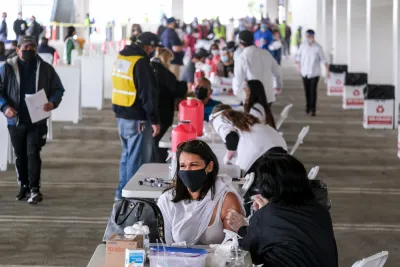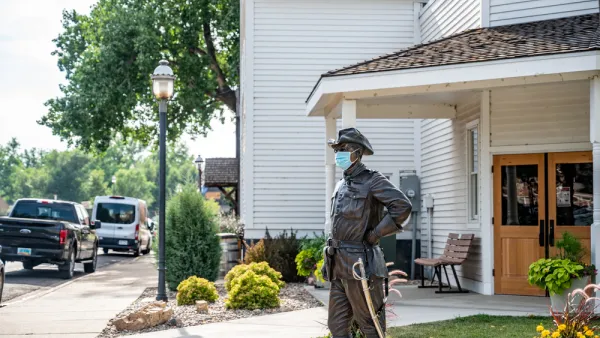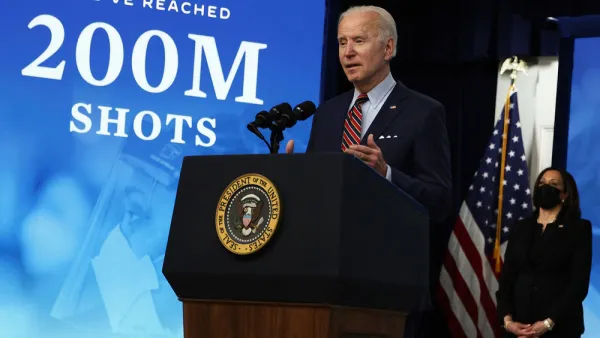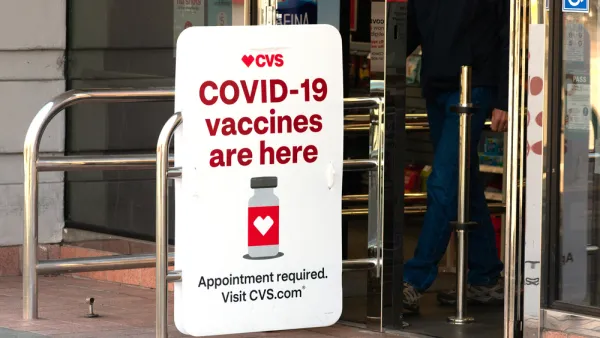The pandemic has largely been measured by case incidence, down significantly in recent weeks in most states. A new metric, the vaccination rate, may determine where the virus strikes next. The urban-rural divide is a major factor, says the CDC.

First, an update on the downward trajectory of the pandemic as of May 24. Case incidence (daily new cases per 100,000 people) has dropped to 8 per 100k. All but the 14 orange-colored ('high risk') states on Covid Act Now's map are below ten per 100k, meaning they are considered 'medium risk.' Daily new cases in the United States on May 23 averaged just over 25,000, down 38% in the last two weeks, the lowest since June 19, according to The New York Times coronavirus database. The national test positivity rate is a relatively low 3%, according to The Washington Post's coronavirus database.
CNBC's healthcare reporter, Berkeley Lovelace Jr., reports on the findings of a new study by the Centers for Disease Control and Prevention, posted online as an Morbidity and Mortality Weekly Report (MMWR) early release on May 18, that highlights vaccination disparities within states based on urban and rural settings. "Coverage by race and ethnicity was not calculated because information on race and ethnicity was missing for 40% of data," note the authors.
"People in rural areas are receiving the Covid-19 vaccines at a lower rate than those in urban areas, potentially hindering the nation’s progress toward ending the pandemic," wrote Lovelace Jr. on May 18.
“Vaccine hesitancy in rural areas is a major barrier that public health practitioners, health care providers, and local partners need to address to achieve vaccination equity,” the CDC wrote in the report.
The new data comes as more studies find rural residents may be more hesitant to get a vaccine. A Kaiser Family Foundation report published in April found 3-in-10 rural residents said they will either “definitely not” get vaccinated or will do so only if required.
In addition to hesitancy, other factors make rural areas more vulnerable to the coronavirus than most urban counties, noted the summary of the report.
Residents of rural communities are at increased risk for severe COVID-19–associated morbidity and mortality. In September 2020, COVID-19 incidence (cases per 100,000 population) in rural counties surpassed that in urban counties.
[See related post: "The Changing Geography of the Pandemic," August 27, 2020, that marks the increase in cases in the Upper Midwest at the end of the summer surge.]
Rural communities often have a higher proportion of residents who lack health insurance, live with comorbidities or disabilities, are aged ≥65 years, and have limited access to health care facilities with intensive care capabilities, which places these residents at increased risk for COVID-19–associated morbidity and mortality.
CDC Director Dr. Rochelle Walensky addressed the early release of the study during the press briefing of the White House COVID-19 Response Team on May 18.
In this analysis — which looked at vaccination rates through April 10th, 2021 — COVID-19 vaccination coverage was lower in rural counties, approximately 39 percent; compared with urban counties, approximately 46 percent. This was true for counties across the country, across all age groups, and among men and women.
We remain committed to listening and to reaching out to communities in every corner of the United States in our work to narrow these differences and make sure that vaccine coverage is equitable regardless of whether you are live in rural or urban areas.
The finding that urban residents were more likely to be vaccinated than rural residents was not universal. In 10% of the jurisdictions (states) analyzed, there was no difference in vaccination coverage, and in 10%, rural counties had greater coverage.
As for classifying the county as urban or rural, CDC used the six metropolitan/micropolitan categories described in the "2013 National Center for Health Statistics (NCHS) urban-rural classification scheme for counties" [pdf].
To further classify counties into two categories (urban versus rural), four of these six categories (large central metropolitan, large fringe metropolitan, medium metropolitan, and small metropolitan) were combined into urban areas, and two (micropolitan and noncore) were combined into rural areas.
The exceptions
The first table below the report shows the vaccination percentages for each of the six categories, followed by the urban and rural classification. Alaska, Arizona, and New Hampshire were the main jurisdictions where rural residents were more likely to be vaccinated than urban residents.
The study, "Disparities in COVID-19 Vaccination Coverage Between Urban and Rural Counties — United States, December 14, 2020–April 10, 2021," is posted on MMWR.
Where cases are increasing
While cases are headed downward in most states, there are exceptions. Most notable is Wyoming, which cases have increased by 21% in the last two weeks to 14 per 100,000, according to the Times database. During the last week, the Virgin Islands, Mississippi, Wyoming, and Rhode Island have increased by 71%, 28%, 26%, and 13%, respectively.
-
Experts: Fourth Coronavirus Surge Likely More of a Ripple, March 11, 2021
-
Post-Pandemic: Living with COVID, January 31, 2021
-
The Impact of COVID-19 on Rural Areas, October 26, 2020
FULL STORY: CDC study finds disparities in Covid vaccine rates between rural and urban areas

National Parks Layoffs Will Cause Communities to Lose Billions
Thousands of essential park workers were laid off this week, just before the busy spring break season.

Retro-silient?: America’s First “Eco-burb,” The Woodlands Turns 50
A master-planned community north of Houston offers lessons on green infrastructure and resilient design, but falls short of its founder’s lofty affordability and walkability goals.

Delivering for America Plan Will Downgrade Mail Service in at Least 49.5 Percent of Zip Codes
Republican and Democrat lawmakers criticize the plan for its disproportionate negative impact on rural communities.

Test News Post 1
This is a summary

Test News Headline 46
Test for the image on the front page.

Balancing Bombs and Butterflies: How the National Guard Protects a Rare Species
The National Guard at Fort Indiantown Gap uses GIS technology and land management strategies to balance military training with conservation efforts, ensuring the survival of the rare eastern regal fritillary butterfly.
Urban Design for Planners 1: Software Tools
This six-course series explores essential urban design concepts using open source software and equips planners with the tools they need to participate fully in the urban design process.
Planning for Universal Design
Learn the tools for implementing Universal Design in planning regulations.
EMC Planning Group, Inc.
Planetizen
Planetizen
Mpact (formerly Rail~Volution)
Great Falls Development Authority, Inc.
HUDs Office of Policy Development and Research
NYU Wagner Graduate School of Public Service





























